Narrow sky
|

According to the legend, Narrow sky was the gully formed as a result of a mountain quake at Dagangshan Mountain during the 36th year of Yongli era (1682); the sky looks just like a line when looked at from inside the cave, thus the name Narrow sky. It is very similar to the Narrow sky in Kenting National Park. The landscape inside the cave is original and natural, with numerous stalactite traces; however, it is a pity that some of them have already been destroyed by people. The wiggling tree nearby the cave entrance is a Ficus caulocarpa.
The Houshanyan Shihmuru (stone breasts) of Dagangshan Mountain is located on Gangan Road of Nanan Village, which is approximately a 10 minute walk when going upwards along the path behind Chaoyuan Temple; it is after one passes the stairs next to Bishuei (Blue water) Cave. Locals state that the ancient name for Shihmuru (stone breasts) was Jhumuru (breasts of a sow) due to the shape of stalactite; the Shimuru (stone breasts) drips water all year long, and it is also the best spot to observe stalactites. Shihmuru (stone breasts) was discovered two centuries ago, and the local people of that time worshipped Shihmuru (stone breasts); whenever the children got ill, the parents would catch the water that dripped down from Shihmuru (stone breasts) for the children to drink, and the children would heal very soon, thus the local people also call Shihmuru (stone breasts) the Shihmu goddess.
|
| |
Danantian Fude Temple
|

This temple was constructed during the 14th year of the Cianlong Dynasty (1749) by Taiwan Prefect, Mr. Jiang (named Syun); he decided to construct Danantian Fude Temple here for the enshrinement of Fu-De-Jheng-Shen (Land God) during his visit to the frontend of Dagangshan mountain, where he witnessed the breathtaking environment surrounded by magnificent mountains, green forests and the streaming water in Erren River. It has been shining upon the people for more than three centuries until now.
Fu-De-Jheng-Shen looks after his people with a position as mighty as the sky and the earth, and he is illustrious and orthodox. The devout men and women from Alian Township and the second township of Tianliao are able to remain safe and sound as well as healthy due to his powers protecting the people and the country. The devout men and women greatly appreciate his gracious glory, with the faith growing each day. During the 47th year prior to Taiwanese year (Shei-Cih-Ji-Sih-Nian; 1865, Fude Temple was dilapidated due to the lake of renovation for a long period of time. The faithful believers did not succeed in repairing the temple after discussion, and then the Japanese forbid civilians to worship anymore during the Second World War. The temple was abandoned until the 34th Taiwanese year (1945), when Taiwan had succeeded in land restoration. The people and the entire country joined in the jubilation, and the faithful believers has the idea to repair the temple in the 36th Taiwanese year (1947), but was procrastinated time after time; finally, the people set their minds determined during the 43rd Taiwanese year (1954), and the repair of the temple was eventually completed with a brand new look.
More and more people began to believe in Fu-De-Jheng-Shen, therefore there was a need to expand the temple with so many believers; in the 61st Taiwanese year (1972), the organizational reconstruction committee recommended Jhu Wan-Cheng, who was born in Tianliao Township, to become the director commissioner; with their donation of land and a few discussions, they had finally reached a satisfactory conclusion. They even invited Jiou-Tian-Syuan-Nyu (Sky-patching Goddess) from Jianshan Temple of Alian to the groundbreaking ceremony for the construction of the temple and the east and west buildings. After four years of time, the construction was completed with brand new appearance of archaic environment and beautifully painted and carved beams and posts, where its grand manner will live on forever.
Legend has it that the Land God is an extremely generous and merciful person; we have been praying to the Land God since the Han Dynasty, where ancestors worshipped the Land God for safety and abundant harvests of crops.
This township is a typically unsophisticated farm village, where most villagers lived on agricultural products; that is why they have a profound worship attitude towards the Land God. On the birthday of Fu-De-Jheng-Shen, which is on February 2nd of every Chinese Calendar, the number of devout men and women visiting this temple even come and go in a stream, regardless of from afar or the neighborhood.
|
| |
Takang Shan Golf
|
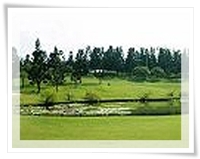
It is a graceful gathering by the foot of Dagangshan Mountain, where comfortable recreational space, delicacies, and deluxe conference center are offered underneath the grand hall; welcome to the perfect place for health and leisure.
 |
| |
Rihyue (Sun Moon) Temple
|
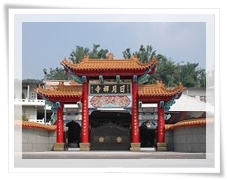
Located within the Chongde Village, and was established by the Yuanzong Monk when he purchased a land of an area of 5868 square meters during 1972. Surrounded by mountains with magnificent manner and astonishing landscapes, it stands by the foot of Moon World Mountain, which adds one more scenic spot to the desolated mountain region.
The ground-breaking ceremony was held on Chinese calendar June 19th, 1973; with Yuanzong Monk and the others collecting alms regardless of the hardship, the temple was finally completed, and the inauguration was set on December 12th, 1977. With the majestic temple standing upright in great manner, the scenery of Moon World has an additional sentiment of dignity and tranquility.
Yuanzong Monk was born in Tianliao Township of Kaohsiung County during 1937. He decided to become a monk when he was 16 at the old Chaofong Temple of Dagang Mountain. He was consulted by Shihpu Temple of Taipei City during 1959 with regards to the restricted regulations to be obeyed by monks. He has abundant career experiences including the director of student affairs at Taichung Cihming Buddhiam Institute; vice group leader of China Buddhist Association; executive director of Taiwan Buddhist Chapter; director of China Buddhist Association; and director of Kaohsiung County Buddhist Association. He is frequently invited overseas to pass on Buddhism, including regions such as Hong Kong, Malaysia, Singapore, Thailand, Japan, Korea, United States and Canada etc.
Yuanzong Monk was never behind when it came to matters regarding social benefits, charity, public welfare, cultural industry, console army and disaster relief. He always worked with a generous heart of Buddha, and the visions of “Love unconditionally even with those that you don’t know, and sympathize with generosity.” Furthermore, during the annual San-Tan-Da-Jie-Huei (forum for restricted regulations for monks) held in Taiwan through out the past years, Yuanzong Monk has participated in numerous activities to pass on the wisdom of Buddhism.
In celebration of the 20th anniversary for Rihyue (Sun Moon) Temple during 1991, the San-Tan-Da-Jie-Huei (forum for restricted regulations for monks) was organized by Yuanzong Monk, with approximately 1600 people coming from all places to participate in this event, which was the largest since all these years. San-Tan-Da-Jie-Huei (forum for restricted regulations for monks) was once again organized during November of the 86th Taiwanese year (1997); with six years of endeavor, the facilities in Rihyue (Sun Moon) Temple were much more complete, and the holy place offers to the people an even better place for practicing the rules.
Yuanzong Monk, the founder of Rihyue (Sun Moon) Temple has led all four types of Buddhists to practice Buddhism with justness to search for fulfillment of a satisfactory life; the temple is renowned throughout the country, where believers, tourists and pilgrims from all places come and visit like an endless stream. The seeds of bodhi spread out from Rihyue (Sun Moon) Temple finally made obvious accomplishments after more than thirty years of endeavor. Rihyue (Sun Moon) Temple not only takes on the burden of inheriting the Buddhism property, but also the mission of enhancing and glorifying Buddhism in order to pass on the intelligence of Buddha, and to establish a better future for Buddhism.
|
| |
Moon World
|
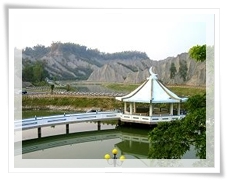
It is located in the region of Chongde Village and Guting Village, with Erren River as the border and neighboring to Tainan County. The landscape of Moon World is the distributed region for Gutingken formation, with the center of Moon World being a low-laying valley; this is surrounded by mainly bare mountain ridges, protruding and looking like a saw, which makes it a harsh condition for plantations to grow. The terrain of this basin appears to be sharp and protruded due to the impact by rainfalls over a long period of time. The sceneries of this place reflected in the still water seem like Guangyuehangong (desolated palace with only moon light) with the bright moon hanging up in the sky, thus the name of “Moon World” was derived. It is the best place to enjoy the moon on a misty night of Mid Autumn Festival.
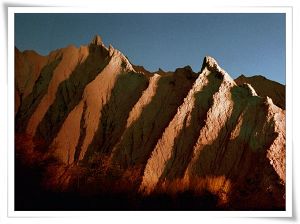 The terrain for Moon World in the early days used to be distributed with low hills, with approximately 2-10 meters of gravel and sand on top of the mudstone; due to the fact of rising land and the erosion by Erren River, the gravel gradually got segmented and scrubbed lost, revealing the underneath mudstone. The rainfalls in this region are concentrated during the three months from June, July to August, and are mainly torrential rains brought by Southwest Monsoon and typhoon, which can easily refine the granules, in which the loose structure and low permeance of the mudstone result in being washed away as mud flow, causing the hillside to collapse, and in the end, forming the landscapes of sharp ridges and no plantations for the Moon World nowadays. The terrain for Moon World in the early days used to be distributed with low hills, with approximately 2-10 meters of gravel and sand on top of the mudstone; due to the fact of rising land and the erosion by Erren River, the gravel gradually got segmented and scrubbed lost, revealing the underneath mudstone. The rainfalls in this region are concentrated during the three months from June, July to August, and are mainly torrential rains brought by Southwest Monsoon and typhoon, which can easily refine the granules, in which the loose structure and low permeance of the mudstone result in being washed away as mud flow, causing the hillside to collapse, and in the end, forming the landscapes of sharp ridges and no plantations for the Moon World nowadays.
|
| |
Moon World Mud Volcano
|

Mud volcanoes are not real volcanoes, but rather a fault section as well as a crack section; it is a result of accumulation of mud and gas spurting from underground, and the height kept increasing with the active mud keep exuding out repeatedly; eventually when the mud overflows the water surface, it appears like a big air bubble bursting in boiling water. The top of the mud can be lit and will burn continuously, proving that there is combustible gas released from underground, which can be an excellent topic for a field trip.
|
| |
Shihmuru (stone breasts)
|
| |
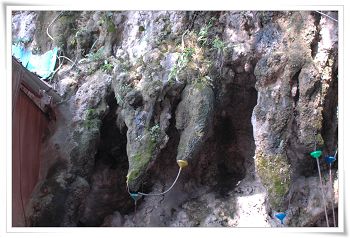 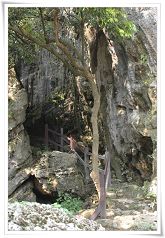
Legend has it that Shihmuru was discovered two centuries ago, and was worshipped by local people for the fact that parents would catch water dripped down from Shihmuru (stone breasts) and fed it to their sick children, and the children would be healed miraculously; that was why it was known as Shihmu goddess to the locals.
It is located on Gangan Road of Nanan Village, with a distance of 10 minutes by walk at the mountain back of Chaoyuan Temple. The name was derived from the shape of the stalactite formed here at Houshanyan of Dagangshan Mountain; it drips water all year long, and is the best location to observe stalactites.
|
| |
Shihzueizai pavilion
|
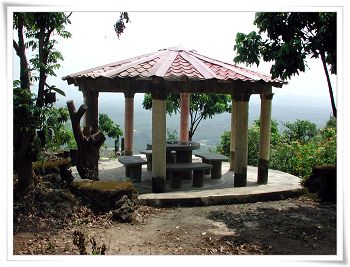
It is located on the back of Chaoyuan Temple in Nanan Village of Tianliao Township, with a distance of approximately ten minutes by walk before arriving at Shihzueizai pavilion. Why not drink a cup of tea, enjoy the breeze and the magnificent sceneries here.
|
| |
Lyu family ancient house
|
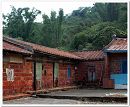
The Lyu family ancient house is located at Nanshih lake of Cising Village, and with a history of more than a century, it is known as the most precious cultural property of Tianliao Township. It is also one of the iconic architectures for mud brick ancient houses with double-entrance; it is a Ci-Bao-San (three wrapped in seven) style ancient housing, with front and rear main halls, and housings on the side such as Shen-Shou (Embracing arms) and Hu-Long (Guarding dragon).
|
| |
Matou (horse head) Mountain
|

It is located on Route 184 at the intersection of Tianliao Township and Cishan Village of Neimen Township; the shape of the mountain resemble very closely to the body of a horse, with the head portion being fairly realistic. Different to that of its surrounding stratum shale is the foreign brownish yellow sandstone. There stands a gigantic independent rock form amongst the vast mudstone in the southwest of Taiwan, and this independent rock form is composed of brownish yellow sandstone; it is mixed within the shale, and with the influence of erosion, this independent rock form appears even more outstanding, which looks like the head of a horse when looked from afar; that wais why local people named it Matou (horse head) Mountain. However, when viewed from another angle, it appears to be an odd shaped gold, thus it is also known as Yinding (silver ingot) Mountain.
|
| |
Chaoyuan Temple
|
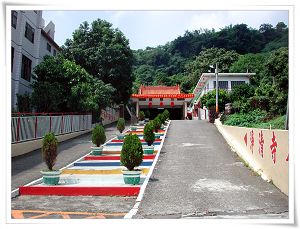
It is located at No. 14, Gangan Road in Nanan Village of this township. It primarily enshrines Guanyin, and secondarily enshrines Rulai Buddha, Sanbao Buddha, Shihjia Buddha, Land God, Shancai and Liangnyu. It is one of the temples enshrining numerous gods in this township.
This temple was built in the 1st year of Cianlong Dynasty, and is extremely popular with a great number of pilgrims. Until the 14th year of Cianlong Dynasty (1749), Mr. Jiang of Tainan Prefect discovered that the temple was located at the foot of the mountain, which would easily be a hideout for bandits; thus, through the use of Feiwa (flying on roof tiles) method, he relocated the temple to the mountain side to construct Chaofong Temple, commonly known as Sinyan. Afterwards, some farmers found a statue of Buddha (with a height of 5 cm) at the old site, and built a shed at the present location for enshrinement; however, when the Japanese dominated Taiwan, the statue of Buddha was abandoned until the restoration of Taiwan, and Chaofong Temple dispatched Monk Lin-Guei to raise a fund for reconstruction at the old site during the 38th Taiwanese year (1949). In the 48th Taiwanese year(1959), Buddhist Association built Associação Religiosa Fat Wa next to this temple.
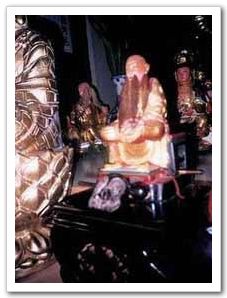 This temple was renovated with the contribution from Mr. Hong Ding-Zai during the 68th Taiwanese year (1979), the temple looked fabulous after the renovation; and in the 72nd Taiwanese year (1983), Master Mingyin was invited to act as the person in charge. The temple is a heavenly place with vast green filed in the front, and numerous mountains in the distance; other than that, it is also the place for spiritual commitment for villagers of this township; on February 19th of every Chinese Calendar, a fiesta would be held where a lot of pilgrims would visit. This temple was renovated with the contribution from Mr. Hong Ding-Zai during the 68th Taiwanese year (1979), the temple looked fabulous after the renovation; and in the 72nd Taiwanese year (1983), Master Mingyin was invited to act as the person in charge. The temple is a heavenly place with vast green filed in the front, and numerous mountains in the distance; other than that, it is also the place for spiritual commitment for villagers of this township; on February 19th of every Chinese Calendar, a fiesta would be held where a lot of pilgrims would visit.
|
|